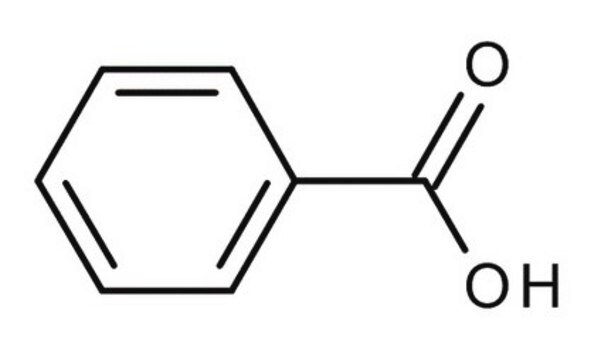12353
Benzoic acid
reference material for titrimetry, certified by BAM, >99.5%
About This Item
Recommended Products
grade
reference material
Quality Level
vapor density
4.21 (vs air)
vapor pressure
10 mmHg ( 132 °C)
Assay
>99.5%
autoignition temp.
1061 °F
quality
certified by BAM
technique(s)
titration: suitable
bp
249 °C (lit.)
mp
121-125 °C (lit.)
solubility
water: soluble (2.9 g/l at 25 °C)
density
1.32 g/cm3 at 20 °C
application(s)
environmental
format
neat
SMILES string
OC(=O)c1ccccc1
InChI
1S/C7H6O2/c8-7(9)6-4-2-1-3-5-6/h1-5H,(H,8,9)
InChI key
WPYMKLBDIGXBTP-UHFFFAOYSA-N
Looking for similar products? Visit Product Comparison Guide
General description
Application
Features and Benefits
- Available as a solid in a secure glass bottle to ensure its stability for the entire shelf life until opened.
- Traceable to NIST SRM
- High-quality offering accurate titer determinations
- Accompanied by a certificate of analysis (CoA)
Analysis Note
Signal Word
Danger
Hazard Statements
Precautionary Statements
Hazard Classifications
Eye Dam. 1 - Skin Irrit. 2 - STOT RE 1 Inhalation
Target Organs
Lungs
Storage Class Code
6.1C - Combustible acute toxic Cat.3 / toxic compounds or compounds which causing chronic effects
WGK
WGK 1
Personal Protective Equipment
Certificates of Analysis (COA)
Search for Certificates of Analysis (COA) by entering the products Lot/Batch Number. Lot and Batch Numbers can be found on a product’s label following the words ‘Lot’ or ‘Batch’.
Already Own This Product?
Find documentation for the products that you have recently purchased in the Document Library.
Customers Also Viewed
Articles
HPLC Analysis of Benzoic Acid and Sorbic Acid on Ascentis® Express RP-Amide ("Green" Mobile Phase Conditions)
Separation of Acetaminophen, meets USP testing specifications, 98.0-102.0%, powder; Caffeine, meets USP testing specifications, anhydrous; Benzoic acid, meets USP testing specifications; Aspirin, meets USP testing specifications
Protocols
Separation of 4-Hydroxybenzoic acid; Acetylsalicylic acid; Benzoic acid; Salicylic acid; Ethyl 4-hydroxybenzoate
HPLC Analysis of Benzoic Acid Derivatives on Ascentis® C18
Our team of scientists has experience in all areas of research including Life Science, Material Science, Chemical Synthesis, Chromatography, Analytical and many others.
Contact Technical Service








